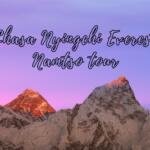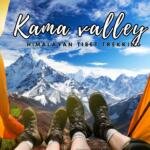Embarking on the Sichuan-Tibet Highway Adventure: A Scenic Drive to the Roof of the World
Unlocking the Beauty of the Sichuan-Tibet Line
The Sichuan-Tibet line has emerged as a sought-after tourism destination, drawing adventurers and nature enthusiasts alike. As roads get better, more tourists opt for self-driving to explore Tibet’s enchanting landscapes. The route from Chengdu to Lhasa is a scenic journey, promising awe-inspiring beauty at every turn.
The Scenic Route: Chengdu to Lhasa
The Sichuan Tibet Highway commences its mesmerizing journey in Chengdu, traversing through Ya’an and Kangding before reaching the picturesque Xinduqiao. Here, the road takes a fascinating turn, offering a crotched path that adds a touch of adventure to the expedition. The northern route weaves through Kartse, Dege, and Chamdo, leading to Bamda, where it merges with the southern route. From Baxue to Lhasa, covering 2412km through Ranwu, Bomi, and Nyingchi, this highway leads to the breathtaking city of Lhasa. Many drivers choose the shorter 2149km south route for its efficiency and captivating landscapes. From Chengdu’s vibrant city life to the serene beauty of Tibet, every mile tells a story of nature’s grandeur.
Challenges Along the Route
While the Sichuan-Tibet line boasts unparalleled beauty, it is not without its challenges. Treacherous terrains, bad roads, and the looming threat of landslides add an element of unpredictability to the adventure. Yet, it is precisely these challenges that make the journey memorable, testing the mettle of those who dare to traverse this extraordinary highway. The Sichuan-Tibet Highway, from Chengdu to Lhasa, is not just a road but an odyssey, transforming into a visual feast of mountains and culture as you drive into Tibet.
Exploring Gems Along the Southern Sichuan-Tibet Route: A Tapestry of Culture and Nature
Danba: A Glimpse into Gyarong Tibetan Life
Nestled in a mountain valley, Danba stands as a small county with a unique charm. Home to the Gyarong Tibetans, this region boasts mild climates and Tibetan-speaking hamlets perched dramatically on 8,000-foot-high mountainsides. Serving as a historical way station, Danba offers a captivating stop on the circuit through China’s southwest, renowned for its exotic travel destinations.
Lithang: A Cultural Haven in the Tibetan Province of Kham
As the county seat of Litang County in western Sichuan Province, Lithang is a cultural hub within the ancient Tibetan province of Kham. Sitting at an elevation of 4000m, it ranks among the world’s highest towns. With a population of around 50,000, Lithang is steeped in Tibetan culture and has been the birthplace of several Dalai Lamas. The local monastery, perched on a hillside just outside the town, adds to the town’s cultural richness.
Lively Litang: Where Tibetan Culture Thrives
Litang thrives with vibrant street life, infused with the energy of nomadic shepherds and Tibetan traders. The town, a major centre of Tibetan culture in Kham, juxtaposes older sections on hill slopes with ongoing construction, expanding into the surrounding grassy plains. While the majority of the population is ethnically Tibetan and bilingual, Mandarin dominates the signage. Located about 8-9 hours to the east, Kangding serves as the closest major city.
Batang: A Lakeside Haven of Breathtaking Beauty
The name Batang translates to “sheep-baaing lakeside,” and indeed, it is one of the most beautiful places on Earth. Nestled amid stunning landscapes, Batang captivates with scenery beyond praise. Visitors often find themselves astonished by the beauty of the people and the surroundings. The overnight stay at a local hotel provides a chance to absorb the enchantment of this picturesque locale.
Southern Sichuan-Tibet Route: A 2250KM Journey of Wonders
Embarking on the Southern Sichuan-Tibet Route unfolds a mesmerizing journey:
- Chengdu: The starting point of the adventure.
- Ya’an: A stepping stone to scenic wonders.
- Xinduqiao: A charming pause amid breathtaking landscapes.
- Litang: A cultural haven in the Tibetan province of Kham.
- Batang: A lakeside paradise with unparalleled beauty.
- Ranwu, Bomi, Linzhi: Scenic gems on the route.
- Gongbu Jiangda: Adding cultural richness to the journey.
- Lhasa: The final destination, where the tapestry of the Southern Sichuan-Tibet Route concludes, leaving travellers with a lifetime of memories.

Unveiling the Mystique: A –Day Journey Through Enchanting Sichuan-Tibet Landscapes
Day 1: Chengdu to Ya’an – Gateway to Ancient Silk and Tea Horse Roads
Gather at the designated location as the sun rises, marking the commencement of an extraordinary adventure. Depart from Chengdu, traversing the Chengya Expressway, covering 147 kilometres to reach Ya’an. This historical town is not just a stop but a gateway to the ancient Southern Silk Road and the Ancient Tea Horse Road. Pass through the Erlang Mountain Tunnel, and as the journey unfolds, arrive at Moxi Ancient Town, the portal to Hailuogou via Luding County. The afternoon allows exploration of the ancient town and the captivating Catholic Church.
Day 2: Hailuogou to Kangding to Xindu Bridge – A Tapestry of Cultural Fusion
Bid farewell to the wonders of Hailuogou Scenic Area and set forth from Moxi Ancient Town towards Kangding Ancient City. Traverse the Tibetan-Chinese dividing line, conquering the barrier outside the Great Wall at 4298 meters above sea level. The journey unfolds into the real Tibetan area, leading to the enchanting Xindu Bridge, also known as “Photography Paradise.” This small town, the junction of the north-south line of Sichuan-Tibet, promises a visual feast and cultural fusion.
Day 3: Xindu Bridge to Litang to Daocheng to Riwa – A Plateau Tapestry Unfolds
As dawn paints the landscape, savour the picturesque scenery of small bridges, flowing water, Tibetan houses, and morning glow. Traverse the Gaoersi Mountain, witness the beauty of the Yalong River, pass through Kamba Mountain Town, and relish the journey through the Tibetan Plateau. Arrive at Litang County, the hometown of the Seventh Dalai Lama, and pass through Daocheng County, where terracotta river valleys and Tibetan villages create a paradise-like scenery. The day’s adventure concludes in Riwa, with Powa Mountain and Chitu River leaving indelible impressions.
Day 4: Riwa to Aden and Back – Pilgrimage to Sacred Peaks
Embark on an early pilgrimage to Xiannai Rishen Mountain, surrounded by the majesty of Xiannuoduoji Mountain and Yangmaiyong Mountain. Immerse yourself in the natural wonders of mountains, snowy peaks, forests, glaciers, lakes, and rivers, experiencing the harmonious coexistence between humanity and nature. Bid farewell to this Shangri-La and relive the intoxicating natural beauty as you return to Riwa.
Day 5: Riwa to Dongwang Grand Canyon to Meili Snow Mountain – A Symphony of Nature
The journey to Meili Snow Mountain unveils breathtaking landscapes. Traverse Rhododendron Mountain, is adorned with the vibrant bloom of rhododendrons in April and May. Pass through Dongwang Grand Canyon, witnessing the turquoise water and sparkling waves alongside the highway. As you approach Meili Snow Mountain, behold the awe-inspiring beauty of nature’s masterpiece.
Notes for the Journey:
Caution is advised for the road ahead, marked by large trucks and potential falling rocks in certain areas. Vigilance ensures safe passage through the mesmerizing landscapes.
Embarking on the Highlands: A Journey of Wonders
Day 6: Meili Snow Mountain to Zuogong via Yanjing Salt Well
As the morning sun graces the landscape, unveiling the majestic Meili Snow Mountain and Sunshine Jinshan, a rare and breathtaking sight, participants are fortunate to witness this natural wonder. Following breakfast, the journey proceeds to Mangkang Salt Well, an intriguing stop in Tibet’s history. Historically, Yanjing served as a vital route from Tubo to Nanzhao, playing a crucial role in transporting Yunnan tea to Tibet. The cultural landscape of Yanjing and Salt Fields stands as the last surviving original salt-dried terrain on the “Ancient Tea Horse Road.” After exploring the Yanjing Scenic Area, and crossing Hongla Mountain, the day concludes with a stay at the Zuogong Hotel.
Day 7: Zuogong to Ranwu via Bangda – Navigating High Altitudes
Departing from Zuogong, the route leads through Bangda, a significant junction at 4,400 meters where the southern and northern Sichuan-Tibet lines intersect. Serving as a crucial transportation hub, Bangda connects to Qamdo in the north and Linzhi and Lhasa in the west. Positioned on the expansive Bangda grassland, it boasts the world’s highest civilian airport. Bid farewell to the grassland, and traverse the formidable Nujiang Mountain, reaching an elevation of 4,839 meters at the mountain pass. Descend through the renowned Ninety-Nine Road, follow the Nu River’s bank, and arrive at Basu.
Day 8: Ranwu Lake to Bomi via Laigu Glacier – A Symphony of Ice and Forests
After breakfast, the journey bids farewell to Ranwu, directing its course towards Laigu Glacier. Nestled in Ranwu Town, Baxu County, Tibet, adjacent to Ranwu Lake, Laigu Glacier stands among the world’s three largest glaciers, serving as the source of Palong Zangbo. The meltwater from ice and snow feeds into Lake Ranwu, surrounded by dense virgin forests and primitive Tibetan villages. Yalong Glacier, stretching 12 kilometres from the main peak of Gangri Gabu Mountain to Gangri Gabu Lake, offers a spectacular display of nature’s grandeur. Leaving the glacier-laden landscapes, the expedition passes Midui Glacier on its way back to Ranwu, ultimately heading to Bomi County for an overnight stay.
Day 9: Bomi to Linzhi – A Symphony of Nature’s Bounty
Commencing from Zam Town in Bomi County, traverse the enchanting virgin forest on the way to the final celestial destination, Tianxian Tongmai, along the Sichuan-Tibet line. With the recently upgraded Tongmai tunnel and bridges, the journey through Tongmai has become more accessible. Navigate the dense forest resembling a sea, known as Lulang, and conquer the snow-clad Sejila Mountain at an elevation of 4702 meters.
Famous for its spectacular azalea blooms in spring and summer, Sejila Mountain also offers the best vantage point for the awe-inspiring Nanga Bawa Peak. Crossing this mountain brings travellers to Nyingchi County, descending all the way to the lower reaches of the Niyang River, just 19 kilometres from Bayi Town. Bayi Township is renowned for its world-famous “King of Cypress Trees.”
Day 10: Linzhi to Lhasa – A Cultural Odyssey
Embark on the next leg of the journey from Nyingchi Town, where the picturesque Niyang River accompanies the route. Legend has it that the Niyang River is formed by the “tears of the goddess,” offering serene and clear waters. The river originates from Mount Mila in the east, flowing over 300 kilometres before merging into the Yarlung Zangbo River. Progressing along the Lhasa River Valley, pass through Daktze, and catch a distant glimpse of the majestic Potala Palace on Red Mountain. The holy city of Lhasa unfolds before your eyes.
Day 11: Lhasa to Yamdrok Lake and Back – The Sacred Lake in the Sky
Embarking in the morning, ascend the Gambara Mountain at an elevation of 4,852 meters. Standing atop the pass, the sacred Yamdrok Lake (4,441 meters) reveals itself as a celestial ribbon suspended between sky and earth. The crystal-clear lake, framed by majestic snow-capped mountains against the blue sky, creates a picturesque panorama. After revelling in the beauty of Yamdrok Lake, return to Lhasa, marking the conclusion of this extraordinary journey through the heart of Tibet.








